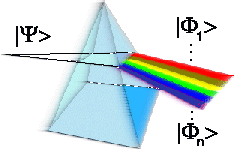Tomasz Świsłocki, Tomasz Karpiuk, and Miroslaw Brewczyk
We investigate the ground state properties of normal and superfluid phases of a mixture of Fermi atoms at zero temperature in a quasi-one-dimensional harmonic trap. Assuming pairing occurs in the Hartree-Fock single-particle states (obtained using atomic orbitals approach) we calculate the spectrum of elementary excitations of the system. We find that for strong enough attraction between different kinds of fermions the state consisting of Cooper pairs becomes energetically favorable. For even stronger attraction a discontinuity located at the Fermi surface appears in the spectrum of elementary excitations. At the same time the chemical potential changes its sign and the system goes from the gas of Cooper pairs to the condensed phase of molecular dimers realizing the BCS to Bose-Einstein condensate crossover in one-dimensional space.
Phys. Rev. A 77, 033603 (2008)
Oct 24, 2007
Aug 17, 2007
Segregation in a noninteracting binary mixture
Filip Krzyżewski and Magdalena A. Załuska-Kotur
Process of stripe formation is analyzed numerically in a binary mixture. The system consists of particles of two sizes, without any direct mutual interactions. Overlapping of large particles, surrounded by a dense system of small particles, induces indirect entropy driven interactions between large particles. Under an influence of an external driving force the system orders and stripes are formed. Mean width of stripes grows logarithmically with time, in contrast to a typical power law temporal increase observed for driven interacting lattice gas systems. We describe the mechanism responsible for this behavior and attribute the logarithmic growth to a random walk of large particles in a random potential created by the site blocking due to the small ones.
Phys. Rev. E 77, 031502 (2008)
Process of stripe formation is analyzed numerically in a binary mixture. The system consists of particles of two sizes, without any direct mutual interactions. Overlapping of large particles, surrounded by a dense system of small particles, induces indirect entropy driven interactions between large particles. Under an influence of an external driving force the system orders and stripes are formed. Mean width of stripes grows logarithmically with time, in contrast to a typical power law temporal increase observed for driven interacting lattice gas systems. We describe the mechanism responsible for this behavior and attribute the logarithmic growth to a random walk of large particles in a random potential created by the site blocking due to the small ones.
Phys. Rev. E 77, 031502 (2008)
Apr 13, 2007
Resonant Einstein–de Haas Effect in a Rubidium Condensate
Krzysztof Gawryluk, Miroslaw Brewczyk, Kai Bongs, and Mariusz Gajda
We theoretically consider a spin polarized, optically trapped condensate of 87Rb atoms in F=1. We observe a transfer of atoms to other Zeeman states due to the dipolar interaction which couples the spin and the orbital degrees of freedom. Therefore the transferred atoms acquire an orbital angular momentum. This is a realization of the Einstein–de Haas effect in systems of cold gases. We find resonances which make this phenomenon observable even in very weak dipolar systems, when the Zeeman energy difference on transfer is fully converted to rotational kinetic energy.
Phys. Rev. Lett. 99, 130401 (2007)
We theoretically consider a spin polarized, optically trapped condensate of 87Rb atoms in F=1. We observe a transfer of atoms to other Zeeman states due to the dipolar interaction which couples the spin and the orbital degrees of freedom. Therefore the transferred atoms acquire an orbital angular momentum. This is a realization of the Einstein–de Haas effect in systems of cold gases. We find resonances which make this phenomenon observable even in very weak dipolar systems, when the Zeeman energy difference on transfer is fully converted to rotational kinetic energy.
Phys. Rev. Lett. 99, 130401 (2007)
Subscribe to:
Comments (Atom)
